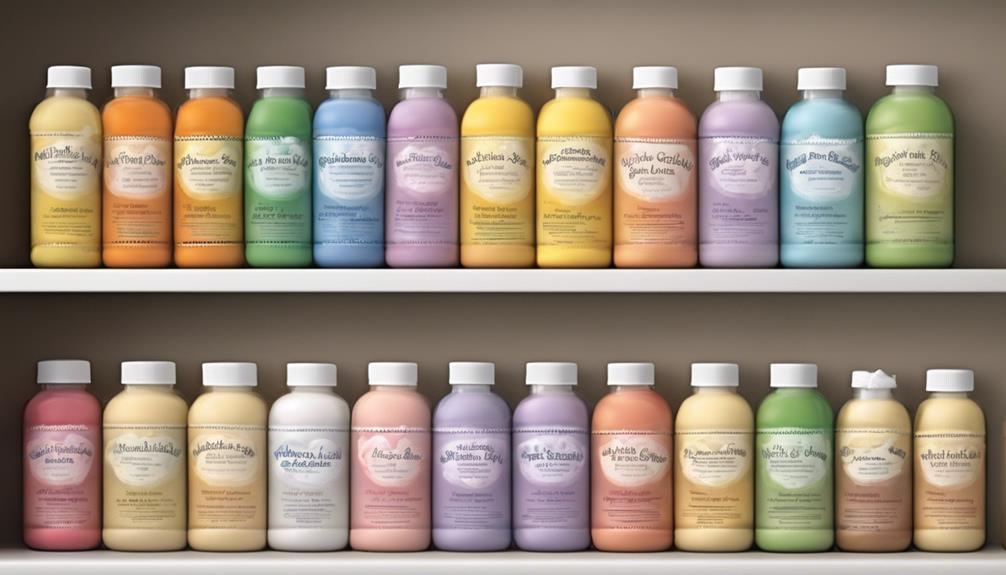As we explore the complex realm of feeding infants, imagine having a dependable compass to lead us through the maze of formula choices and feeding routines.
The Ultimate Formula Feeding Chart stands as a beacon of clarity, shedding light on the nuances of nourishing our little ones.
From deciphering the right formula type to mastering feeding cues, this chart holds the key to opening a world of invaluable knowledge.
So, why not uncover the secrets that could revolutionize your approach to infant nutrition?
Key Takeaways
- Follow formula preparation guidelines for nutritional balance and baby's well-being.
- Adjust feeding amounts based on baby's cues and growth stages.
- Gradually switch formula brands with pediatrician consultation to avoid digestive issues.
- Troubleshoot feeding difficulties with professional guidance and tracking methods.
Types of Baby Formula
When selecting baby formula, it's essential to contemplate the various types available to meet your child's specific nutritional needs. Milk-based formula, particularly iron-fortified options, are popular due to their nutritional richness. For babies with sensitive stomachs, hydrolyzed formula can aid in easier digestion, making it a suitable choice.
In cases of milk allergies or lactose intolerance, soy-based formula provides a viable alternative. Specialized formulas cater to unique requirements such as those of premature infants or babies with metabolic disorders. Organic formulas, free from harmful chemicals and pesticides, offer a natural feeding option for parents seeking a more wholesome choice.
Understanding the differences between these formulas is critical in ensuring your baby receives the best nourishment based on their individual needs. Whether it's addressing sensitive stomachs, milk allergies, or simply opting for an organic solution, the variety available ensures there's a suitable formula for every baby.
Formula Preparation Tips

To maintain proper nutrition and safe feeding practices for your baby, it's important to adhere closely to the recommended mixing ratios provided on the formula label. Following the instructions on the formula packaging guarantees that your infant receives the necessary nutrients without the risk of dilution, which could lead to nutritional deficiencies.
Before introducing water into your baby's diet, it's vital to consult with a pediatrician. Pediatricians can offer tailored feeding guidelines based on your baby's specific needs, guaranteeing they receive the best nutrition.
When preparing formula, pay attention to your baby's hunger cues to establish a feeding schedule that aligns with their appetite. By staying attuned to your baby's needs, you can provide them with the right amount of formula to support their growth and development. Remember, the safety and well-being of your little one are paramount, so always prioritize following the recommended guidelines for formula preparation.
Feeding Amount Guidelines
Let's continue our discussion by exploring the recommended feeding amounts for formula-fed infants. For newborns, it's typical to start with 1 to 3 ounces of formula per feeding to make sure they receive the necessary nutrients.
Infants under 6 months may need around 2 to 2½ ounces of formula per pound of body weight daily. Guidelines suggest offering between 18 to 32 ounces of formula each day, adjusting based on the baby's size and appetite.
Remember, every baby is unique, so it's important to pay attention to their cues and adjust the feeding amounts accordingly. The formula feeding chart is a valuable tool for caregivers to track and manage the appropriate formula amounts for their little ones efficiently.
Switching Formula Brands

Switching formula brands should be done gradually to minimize the risk of digestive issues in infants. It's important to shift slowly by mixing the new formula with the old one in increasing proportions over several days. Sudden changes can lead to digestive problems like gas, bloating, or constipation for babies.
Before making the switch, consulting with a pediatrician is vital to make sure the change is necessary and to receive personalized advice based on your baby's specific needs. Watch out for signs of intolerance or allergies when changing formulas, such as excessive fussiness, rashes, or changes in stool consistency.
Keep a close eye on your baby's reactions to the new formula to assess its importance for their digestion and overall well-being. Tracking these responses will help you determine if the new formula is the right choice for your little one's health.
Troubleshooting Feeding Difficulties
After discussing the importance of switching formula brands gradually to avoid digestive issues, let's now address troubleshooting feeding difficulties that may arise during infant feeding. When it comes to feeding challenges, it's vital to pay attention to cues your baby is giving you. Slow feeding, spitting up, or refusing the bottle could indicate underlying issues. Check the nipple flow, try different burping techniques, and adjust your baby's positioning to find what works best. Monitoring cues for hunger, fullness, or discomfort during feedings can help identify and address problems effectively. Remember, seeking guidance from a pediatrician or lactation consultant can provide personalized solutions to specific feeding challenges. Keeping a feeding journal to track patterns and behaviors is also helpful in pinpointing feeding difficulties. Below is a table summarizing common feeding difficulties and potential solutions:
| Feeding Difficulty | Possible Causes | Troubleshooting Tips |
|---|---|---|
| Slow Feeding | Incorrect flow rate | Try different nipple sizes |
| Spitting Up | Overfeeding or reflux | Burp baby frequently |
| Refusing the Bottle | Nipple preference | Experiment with bottle types |
| Baby's Positioning | Uncomfortable position | Adjust for better alignment |
Frequently Asked Questions
What Do I Need to Know About Ready to Feed Formula?
When it comes to ready-to-feed formula, we find it super convenient – no mixing or measuring, perfect for travel and late-night feeds. Remember to follow storage instructions for quality and safety. Price may vary.
How Much Formula Should I Feed My Newborn Chart?
We start with 1 to 3 ounces for newborns, adjusting as they grow. Feed every 3 to 4 hours, aiming for 2 to 3 ounces. Watch for hunger cues, aim for 8 to 12 feedings daily, and track weight gain and diapers for baby's health.
How Do You Calculate How Much Formula You Need?
We calculate formula needs by multiplying baby's weight by 2 to 2.5 ounces for infants under 6 months. A newborn typically consumes 15-30 ounces of formula daily. Adjust amounts based on hunger cues and growth. Consult a pediatrician for personalized guidance.
How Do You Know What Kind of Formula Your Baby Needs?
We consult our pediatrician to determine the best formula type for our baby's needs. Most infants benefit from milk-based formulas, while hydrolyzed formulas suit those with digestion issues. Soy-based options work for milk allergies.
What Additional Information Does the Formula Feeding Chart Provide Compared to the Formula Feeding Guide?
The stepbystep formula feeding manual provides a detailed breakdown of the feeding quantities and frequencies for different age groups. In comparison, the formula feeding chart offers a visual representation of these details, making it easier to track your baby’s feedings at a glance.
Conclusion
The Ultimate Formula Feeding Chart is the key to revealing successful feeding routines for your little one.
Remember, Rome wasn't built in a day, so be patient and trust the process.
With this all-encompassing guide at your fingertips, you'll be well-equipped to navigate the world of formula feeding with confidence and ease.
Happy feeding!









